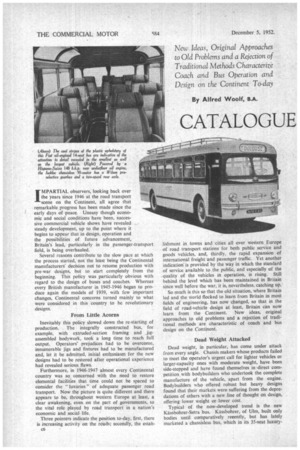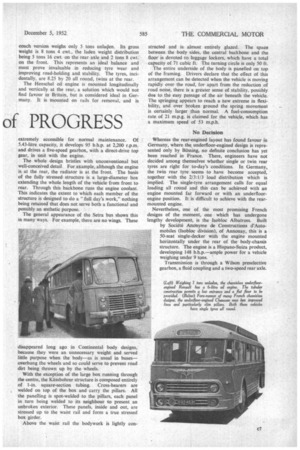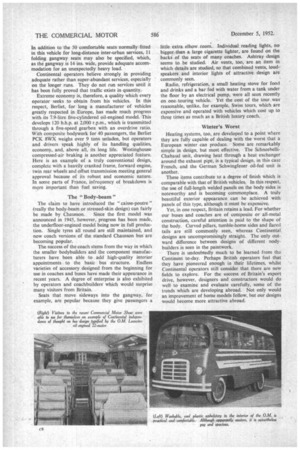CATALOGUE of PROGRESS
Page 44

Page 45

Page 46

If you've noticed an error in this article please click here to report it so we can fix it.
IMPARTIAL observers, looking back over the years since 1946 at the road transport scene on the Continent, all agree that remarkable progress has been made since the early days of peace. Uneasy though economic and social conditions have been, successive commercial vehicle shows have revealed steady development, up to the point where it begins to appear that in design, operation and the possibilities of future advancement, Britain's lead, particularly in the passenger-transport field, is being overhauled.
Several reasons contribute to the slow pace at which the process started, not the least being the Continental manufacturers decision not to resume production with pre-war designs, but to start completely from the beginning. This policy was particularly obvious with regard to the design of buses and coaches. Whereas every British manufacturer in 1945-1946 began to produce again the models of 1939, with few important changes, Continental concerns turned mainly to what were considered in this country to be revolutionary designs.
From Little Acorns Inevitably this policy slowed down the re-starting of production. The integrally constructed bus, for example, with extruded-section framing and jigassembled bodywork, took a long time to reach full output. Operators' prejudices had to be overcome, innumerable jigs and fixtures had to be manufactured and, let it be admitted, initial enthusiasm for the new designs had to be restored after operational experience had revealed serious flaws.
Furthermore, in 1946-1947 almost every Continental country was so concerned with the need to restore elemental facilities that time could not be spared to consider the " luxuries" of adequate passenger road transport. Now the picture is quite different and there appears to be, throughout western Europe at least, a clear awakening, even on the part of governments, to the vital role played by road transport in a nation's economic and social life.
Three pointers indicate the position to-day, first, there is increasing activity on the roads; secondly, the estabc6 lishment in towns and cities all over western Europe of road transport stations for both public service and goods vehicles, and, thirdly, the rapid expansion of international freight and passenger traffic. Yet another indication' is provided by the way in which the standard of service available to the public, and especially of the . quality of the vehicles in operation, is rising. Still behind the level which has been maintained in Britain since well before the war, it is, nevertheless, catching up.
So much is this so that the old situation, where Britain led and the world flocked to learn from Britain in most fields of engineering, has now changed, so that in the field of road-vehicle design at least, Britain can now learn from the Continent. New ideas, original approaches to old problems and a rejection of traditional methods are characteristic of coach and bus design on the Continent.
Dead Weight Attacked Dead weight, in particular, has come under attack from every angle. Chassis makers whose products failed to meet the operator's urgent call for lighter vehicles or larger-capacity ones with moderate weight, have been side-stepped and have found themselves in direct competition with bodybuilders who undertook the complete manufacture of the vehicle, apart from the engine. Bodybuilders who offered robust but heavy designs found that their markets were suffering from the depredations of others with a new line of thought on design, offering lower weight or lower cost.
Typical of the now-developed trend is the new Kassbohrer-Setra bus. Kassbohrer, of Ulm, built only bodies until comparatively recently, but has lately marketed a chassisless bus, which in its 35-seat luxury coach version weighs only 5 tons unladen. Its gross weight is 8 tons 4 cwt., the laden weight distribution being 5 tons 16 cwt. on the rear axle and 2 tons 8 cwt. on the front. This represents an ideal balance and must prove invaluable in reducing tyre wear and improving road-holding and stability. The tyres, incidentally, are 8.25 by 20 all round, twins at the rear.
The Henschel oil engine is mounted longitudinally and vertically at the tear, a solution which would not find favour in Britain, but is considered ideal in Germany. It is mounted on rails for removal, and is
extremely accessible for normal maintenance. Of 5.43-litre capacity, it develops 95 b.h.p. at 2,200 r.p.m. and drives a five-speed gearbox, with a direct-drive top gear, in unit with the engine.
The whole design bristles with unconventional but well-conceived detail. For example, although the engine is at the rear, the radiator is at the front. The basis of the fully stressed structure is a large-diameter box extending the whole length of the vehicle from front to rear. Through this backbone runs the engine coolant. This indicates the extent to which each member of the structure is designed to do a "full day's work," nothing being retained that does not serve both a functional and possibly an wsthetic purpose.
The general appearance of the Setra bus shows this in many ways. For example, there are no wings. These disappeared long ago in Continental body designs, because they were an unnecessary weight and served little purpose when the body—as is usual in buses— overhung the wheels and so could serve to prevent road dirt being thrown up by the wheels.
With the exception of the large box running through the centre, the Kassbohrer structure is composed entirely of 1-in. square-section tubing. Cross-bearers are welded on top of the box and carry the pillars. All the panelling is spot-welded to the pillars, each panel in turn being welded to its neighbour to present an unbroken exterior. These panels, inside and out, are stressed up to the waist rail and form a true stressed box girder.
Above the waist rail the bodywork is lightly con structed and is almost entirely glazed. The space between. the body sides, the central backbone and the floor is devoted to luggage lockers, which have a total capacity of 71 cubic ft. The turning circle is only 50 ft.
The entire underside of the body is panelled on top of the framing. Drivers declare that the effect of this arrangement can be detected when the vehicle is moving rapidly over the road, for apart from the reduction of road noise, there is a greater sense of stability, possibly due to the easy passage of the air beneath the vehicle. The springing appears to reach a new extreme in flexibility, and over broken ground the spring movement is certainly larger than normal A fuel-consumption rate of 21 m.p.g. is claimed for the vehicle, which has a maximum speed of 53 m.p.h.
No Decision
Whereas the rear-engined layout has found favour in Germany, where the underfloor-engined design is represented only by Bussing, no definite conclusion has yet been reached in France. There, engineers have •not decided among themselves whether single or twin rear tyres are right for to-day's conditions. In Germany,. the twin rear tyre seems to have become accepted, together with the 2/3:1/3 load distribution which is implied. The single-tyre arrangement calls for equal loading all round and this can be achieved with an engine mounted far forward or with an underfloorengine position. It is difficult to achieve with the rearmounted engine.
Nevertheless, one of the most promising French designs of the moment, one which has undergone lengthy development, is the Isobloc Albatross. Built by Sociae Andnyme de Constructions d'Automobiles (Isobloc division), of Annonay, this is a 50-seat single-decker with the engine mounted horizontally under the rear of the body-chassis structure. The engine is a Hispano-Suiza product, developing 148 b.h.p.—ample power for a vehicle weighing under 9 tons.
Transmission is through a Wilson preselective gearbox, a fluid coupling and a two-speed rear axle.
In addition to the 50 comfortable seats normally fitted in this vehicle for long-distance inter-urban services, 11 folding gangway seats may also be specified, which, as the gangway is 14 ins, wide, provide adequate accommodation for an unexpectedly heavy load.
Continental operators believe strongly in providing adequate rather than super-abundant services, especially on the longer runs. They do not run services until it has been fully proved that traffic exists in quantity.
Extreme economy is, therefore, a quality which every operator seeks to obtain from his vehicles. In this respect, Berliet, for long a manufacturer of vehicles greatly respected in Europe, has made much progress withits 7.9-litre five-cylindered oil-engined model. This develops 120 b,h.p. at 2,000 r.p.m., which is transmitted through a five-speed gearbox with an overdrive ratio. With composite bodywork for 40 passengers, the Berliet PCK 8WX weighs over 9 tons unladen, but operators and drivers speak highly of its handling qualities!, economy, and, above all, its long life. Westinghouse compressed-air braking is another appreciated feature. Here is an example of a truly conventional design, complete with a heavily cranked frame, forward engine, twin rear wheels and offset transmission meeting general approval because of its robust and economic nature. In some parts of France, infrequency of breakdown is more important than fuel saving.
The " Body-beam "
The claim to have introduced the " caisse-poutre " (really the body-beam or stressed-skin design) can fairly be made by Chausson. Since the first model was announced in 1945, however, progress has been made, the underfloor-engined model being now in full production. Single tyres all round are still maintained, and now coach versions of the standard Chausson bus are becoming popular.
The success of the coach stems from the way in which the smaller bodybuilders and the component manufacturers have been able to add high-quality interior appointments to the basic bus structure. Endless varieties of accessory designed from the beginning for use in coaches and buses have made their appearance in recent years. A degree of enterprise is also exhibited by operators and coachbuilders which would surprise many visitors from Britain.
Seats that move sideways into the gangway, for example, are popular because they give passengers a little extra elbow room.. Individual reading lights, no bigger. than a large cigarette lighter, are found on the backs of the seats of many coaches. Ashtray design seems to be studied_ Air vents, too, are an item in which details are studied, so that combined vents, loudspeakers and interior lights of attractive design are commonly seen.
Radio, refrigeration, a small heating stove for food and drinks and a bar fed with water from a tank under the floor by an electrical pump, were all seen recently on one. touring vehicle. Yet the cost of the tour was reasonable, unlike, for example, Swiss tours, which are expensive and operated with vehicles which cost up to three times as much as a British luxury coach.
Winter's Worst
Heating systems, too, are developed to a point where they are fully capable of dealing with the worst that a European winter can produce. Some are remarkably simple in design, but most effective. The SchneebelliChabaud unit, drawing heat through a heat exchanger around the exhaust pipe, is a typical design, in this case French, and the German Schwingfeuer oil-fed unit is another.
These items contribute to a degree of finish which is comparable with that of British vehicles. In this respect, the use of full-length welded panels on the body sides is noteworthy and is becoming commonplace. A truly beautiful exterior appearance can be achieved with panels of this type, although it mustbe expensive.
Yet, in one respect, Britain retains a lead. For whether our buses and coaches are of composite or all-metal construction, careful attention is paid to the shape of the body. Curved pillars, tumble-home sides and flared tails are still commonly seen, whereas Continental, designs are uncompromisingly straight. The only outward difference between designs of different bodybuilders is seen in the paintwork.
There is undoubtedly much to be learned from the Continent to-day. Perhaps British operators feel that they have pioneered enough in their lifetimes, whilst Continental operators still consider that there are new fields to explore. For the success of Britain's export drive, however, designers and constructors would do well to examine and evaluate carefully, some of the trends which are developing abroad. Not only would an improvement of home models follow, but our designs would become more attractive .abroad.




















































































